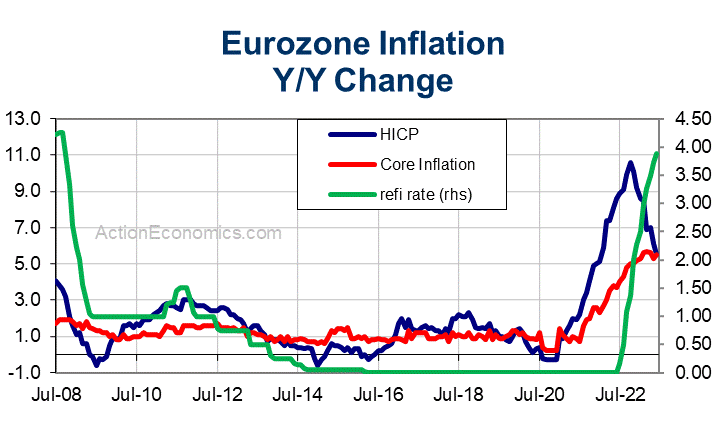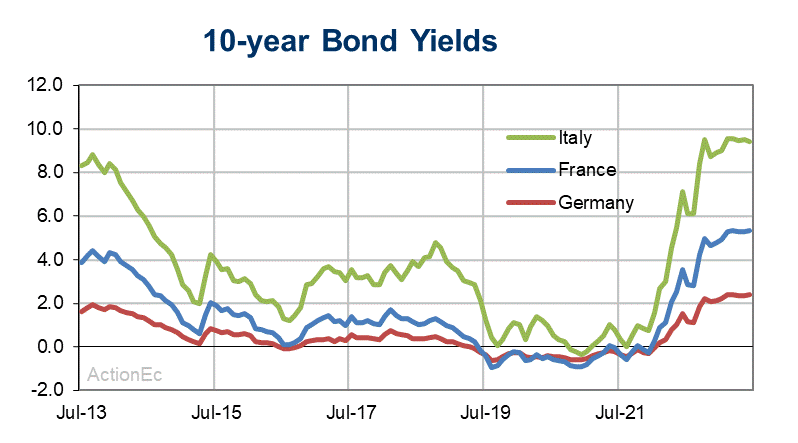||
The ECB is expected to deliver another 25-basis point hike next week, while keeping all options open for September. This will mean the presser should be a tad more dovish than in June, when Lagarde signaled more tightening is underway. However, while a September hike is far from certain, it remains a strong possibility, as inflation is still running at more than twice the target.
Eurozone HICP was confirmed at 5.5% y/y in June, down from 6.1% y/y in the previous month. This marked a further decline largely thanks to the drop in oil and gas prices in recent months. Energy prices were down -5.6% y/y at the end of the second quarter, compared to a 42.0 y/y rise in June of 2022. Energy actually subtracted -0.57% points from the annual rate, but at the same time the jump in energy and basic goods prices early in 2022 has continued to feed through the product chain, and prices for non-energy industrial goods were still 5.5% higher than in June of last year. This is down from a peak of 6.8% y/y in February however, and PPI inflation is also coming down. Services price inflation accelerated to 5.4% y/y from 5.0% y/y, and the core rate excluding energy, food, alcohol and tobacco rose to 5.5% y/y from 5.3% y/y.
Sticky core inflation is keeping the ECB on course to deliver another 25-basis point hike next Thursday. Lagarde already flagged the move at the previous meeting, and comments from council members since then have confirmed that the decision is not contested. That means the main focus next week will be on the statement and the press conference. Last time around Lagarde not only announced a 25 basis point hike, but effectively set the central bank on course for additional tightening. This time, the statement is likely to be much more balanced with all options for September still on the table. This could give the statement a comparatively dovish tilt, as not just the doves see signs that underlying inflation is plateauing.

While core inflation unexpectedly move higher last month, this was to a large extent due to special factors and base effects from the introduction of cheap subsidized rail travel in Germany over the summer of 2022. Furthermore, PPI inflation is coming down, and there are more signs that the labour market is somewhat less tight than it was, whereas previous rate hikes are feeding through to the economy and are suppressing loan demand. The ECB flagged this in the last monthly report, which stressed that “tighter financing conditions are a key reason why inflation is projected to decline further towards target, as they are expected to increasingly dampen demand”.
The fight against inflation isn’t over and yet, but even ECB hawk Knot suggested earlier in the week that with the next hike, the risk of over-tightening is becoming more real. This means the ECB needs to be cautious. Basing any decision on all available data is even more crucial now than it was at the start of the tightening cycle. But with the ECB effectively on holiday after next week’s decision, there is a long gap before the September 14 meeting, with two more sets of inflation numbers until then. The next set of staff projections is also due at the end of the third quarter, and committing too early to additional moves would risk having to backtrack, or not being able to react to new information coming out over the next one and a half months.
Not even the hawks seem to be ready to do that. ECB council member Knot said this week that following next week’s decision the ECB needs to “carefully watch what the data tell us on the distribution of risks surrounding the baseline”. He also seemed to push back against speculation of further hikes after the summer saying that additional tightening is a “possibility, but by no means a certainty”. The dovish camp has started to warn against the risk of over-tightening, and chief economist Lane also recently highlighted that “the typical lags in monetary transmission mean that the full economic impact of the considerable monetary tightening over the last year will only play out over the next couple of years”.
Failing to commit to another hike will give the statement a dovish twist compared to the previous announcement, and if Lagarde will want to keep all options on the table for September, she will have to prevent markets from running away with the idea that rates have peaked already. The ease of this will be depend on the message from the Fed just a day before — on Wednesday. Lagarde will likely also push back against any suggestion that the central bank will have to change tack and start cutting rates early next year. Even if next week were to be the last hike in the current cycle, the hawks will push for a clear signal that rates will have to remain in restrictive territory for an extended period.

Keeping all options on the table for September means that a September hike is still a possibility. Indeed, in our view that ECB is likely to deliver another 25 basis points in hike after the summer break. This is also the market consensus, as well as the prediction of the latest interest rate surveys from both Reuters and Bloomberg. The noise from base effects in German service price inflation aside, the most difficult part for the ECB to predict will be wage costs. There are signs that the labour market isn’t quite as tight as it was and that overall growth this year will be weaker than hoped at one point. This is partly a reflection of the sluggish recovery in China, but also the sharp rise in interest rates not just in the Eurozone. Demand is slowing, but with structural unemployment high across the Eurozone and wages still reacting to the erosion of real disposable income last year, the risks are tilted to the upside.
The ECB’s staff projections from June see headline HICP at 2.2% in 2025 — which would still be above target. And, there are still plenty of upside risks to the price outlook. So far China’s sluggish recovery has helped to keep a lid on international energy prices, while the Black Sea Grain Initiative saw food price inflation coming down from the highs seen after Russia’s invasion of Ukraine. However, Russia just cancelled that arrangement, and China is stepping up efforts to boost domestic demand and overall activity. Uncertainty about the global growth outlook, and thus about price pressures, remains high. Another hike in September may not be a certainty, but for now it remains a strong possibility.
Click here to access our Economic Calendar
Andria Pichidi
Market Analyst
Disclaimer: This material is provided as a general marketing communication for information purposes only and does not constitute an independent investment research. Nothing in this communication contains, or should be considered as containing, an investment advice or an investment recommendation or a solicitation for the purpose of buying or selling of any financial instrument. All information provided is gathered from reputable sources and any information containing an indication of past performance is not a guarantee or reliable indicator of future performance. Users acknowledge that any investment in Leveraged Products is characterized by a certain degree of uncertainty and that any investment of this nature involves a high level of risk for which the users are solely responsible and liable. We assume no liability for any loss arising from any investment made based on the information provided in this communication. This communication must not be reproduced or further distributed without our prior written permission.
||
-----------------------------------------------------
By: Andria Pichidi
Title: ECB to Hike Again
Sourced From: /713361/
Published Date: Fri, 21 Jul 2023 07:18:33 +0000
Read More
Did you miss our previous article...
https://peaceofmindinvesting.com/tools/the-us-dollars-position-strengthens-as-expectations-grow-overview-of-july-21-2023
.png) InvestingStocksToolsClubsVideosPrivacy PolicyTerms And Conditions
InvestingStocksToolsClubsVideosPrivacy PolicyTerms And Conditions
